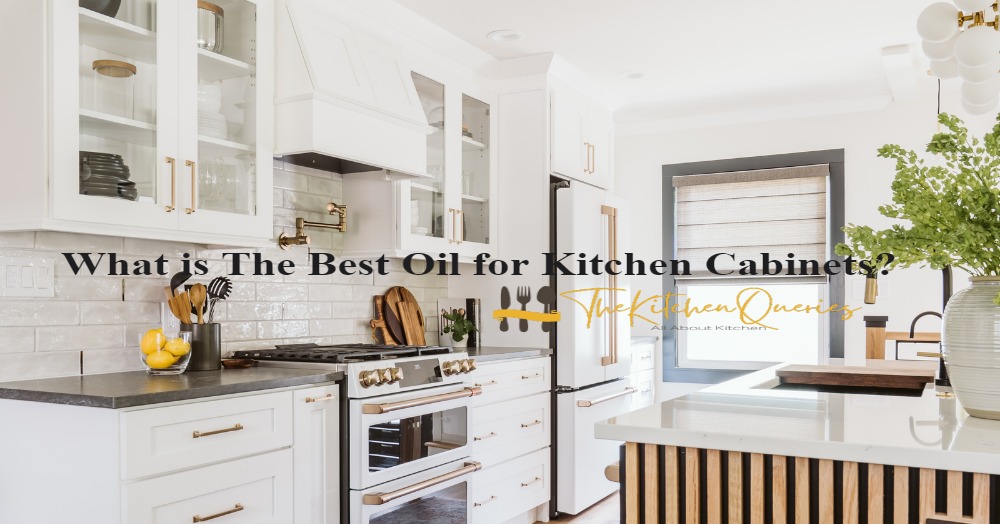When it comes to maintaining and enhancing the beauty of your kitchen cabinets, selecting the right oil is paramount.
The type of oil you choose can significantly impact your cabinets’ appearance, durability, and overall quality.
In this article, we’ll delve into the world of kitchen cabinet oils, exploring different types and factors to consider when making your selection.
So, let’s dive in and discover how to keep your kitchen cabinets looking their best for years.
I. Understanding Different Types of Oils:

Before diving into the specifics of which oil is best for your kitchen cabinets, it’s essential to understand the different types of oils commonly used for this purpose.
Each type of oil offers unique characteristics and benefits, so let’s take a closer look at some of the most popular options:
- Tung Oil: Tung oil is derived from the seeds of the tung tree and is known for its exceptional durability and water resistance. It penetrates deep into the wood, providing long-lasting protection against moisture and stains.
- Linseed Oil: Made from flaxseed, linseed oil is a traditional choice for wood finishing. It enhances the natural beauty of the wood, giving it a warm, rich appearance. However, linseed oil takes longer to dry compared to other oils and may require multiple coats for optimal protection.
- Walnut Oil: Walnut oil is derived from walnut tree nuts and is prized for its natural color and sheen. It offers moderate protection against moisture and can help highlight the grain patterns in the wood.
- Soybean Oil: Soybean oil is a renewable and eco-friendly option for treating kitchen cabinets. It provides good protection against water and stains and is easy to apply and maintain.
- Mineral Oil: Mineral oil is a petroleum-derived product commonly used for conditioning and protecting wood surfaces. While it doesn’t offer the same level of durability as other oils, it is food-safe and ideal for cutting boards and butcher blocks.
Each of these oils has its advantages and considerations, so it’s essential to weigh your options carefully before making a decision.
Factors such as durability, appearance, and ease of application will influence which oil is best suited to your needs.
II. Factors to Consider When Choosing Oil:

When selecting the right oil for your kitchen cabinets, several factors should be taken into consideration to ensure optimal results. Here are some key considerations to keep in mind:
- Durability: One of the most important factors to consider is the durability of the oil. You’ll want to choose an oil that provides long-lasting protection against moisture, stains, and daily wear and tear. Look for oils that penetrate deep into the wood and create a strong barrier against environmental damage.
- Appearance: The oil you choose will significantly impact the appearance of your kitchen cabinets. Some oils enhance the natural color and grain of the wood, while others may darken or alter its appearance. Consider the desired aesthetic effect you want to achieve and choose an oil that complements your overall design scheme.
- Ease of Application: The application process can vary depending on the type of oil you choose. Some oils require multiple coats and meticulous preparation, while others can be applied quickly and easily with a brush or cloth. Consider your level of experience and the amount of time you’re willing to invest in the application process.
- Toxicity: It’s essential to consider the toxicity of the oil, especially if you have children or pets in the home. Opt for oils that are food-safe and non-toxic to ensure the safety of your family.
By carefully considering these factors and weighing your options, you can select the best oil for your kitchen cabinets that meets your specific needs and preferences.
III. Best Oils for Kitchen Cabinets:

When it comes to choosing the best oil for your kitchen cabinets, several options stand out for their durability, appearance, and ease of application.
Let’s explore some of the top choices:
- Tung Oil: Tung oil is renowned for its exceptional durability and water resistance. It penetrates deep into the wood, forming a protective barrier that helps prevent moisture damage and stains. Tung oil also enhances the natural beauty of the wood, giving it a warm, rich finish.
- Linseed Oil: Derived from flaxseed, linseed oil is a traditional favorite for wood finishing. It offers a beautiful, natural sheen and helps bring out the grain patterns in the wood. While linseed oil takes longer to dry compared to other oils, it provides excellent protection and a timeless aesthetic.
- Walnut Oil: Walnut oil is prized for its rich color and lustrous finish. It enhances the natural beauty of the wood while providing moderate protection against moisture and stains. Walnut oil is easy to apply and leaves behind a smooth, satin-like surface.
- Soybean Oil: Soybean oil is a renewable and eco-friendly option for treating kitchen cabinets. It offers good protection against water and stains while being easy to apply and maintain. Soybean oil is also food-safe, making it a popular choice for kitchen surfaces.
- Mineral Oil: Mineral oil is a versatile option for conditioning and protecting wood surfaces. While it may not offer the same level of durability as other oils, it is food-safe and ideal for use on cutting boards and butcher blocks. Mineral oil is easy to apply and provides a natural, matte finish.
Ultimately, the best oil for your kitchen cabinets will depend on your specific needs and preferences.
Consider factors such as durability, appearance, and ease of application when making your decision, and choose an oil that will keep your cabinets looking beautiful for years to come.
IV. Application Process:

Applying oil to your kitchen cabinets is a straightforward process, but it requires careful preparation and attention to detail to ensure optimal results.
Here’s a step-by-step guide to help you through the application process:
- Preparation: Before applying oil, ensure that your cabinets are clean and free from any dirt, grease, or previous finishes. Use a mild detergent and warm water to clean the surfaces thoroughly, then allow them to dry completely.
- Sand the Surfaces: For best results, lightly sand the surfaces of your cabinets with a fine-grit sandpaper. This will help to smooth out any imperfections and open up the wood pores, allowing the oil to penetrate more effectively.
- Apply the Oil: Using a clean, lint-free cloth or brush, apply a thin, even coat of oil to the surfaces of your cabinets. Work in small sections, applying the oil in the direction of the wood grain for a smooth, uniform finish.
- Allow to Penetrate: After applying the oil, allow it to penetrate the wood for the recommended amount of time specified by the manufacturer. This will vary depending on the type of oil you’re using, so be sure to read the instructions carefully.
- Wipe off Excess: Once the oil has had time to penetrate, use a clean cloth to wipe off any excess oil from the surface of the cabinets. Be thorough but gentle, ensuring that all excess oil is removed to prevent drips or streaks.
- Repeat as Necessary: Depending on the desired level of protection and sheen, you may need to apply multiple coats of oil. Allow each coat to dry completely before applying the next, and follow the same process of application and wiping off excess oil.
- Allow to Cure: Finally, allow the oil to cure completely according to the manufacturer’s instructions before using your cabinets. This typically involves allowing the oil to dry and harden for a specified period, during which time it will fully bond with the wood surface.
By following these steps and taking care to properly prepare and apply the oil, you can achieve beautiful, long-lasting results that will protect and enhance the appearance of your kitchen cabinets.
V. Maintenance Tips:

Once you’ve applied oil to your kitchen cabinets, it’s essential to maintain them properly to ensure they retain their beauty and durability for years to come.
Here are some maintenance tips to help you keep your cabinets looking their best:
- Regular Cleaning: Regularly clean your cabinets with mild detergent and warm water to remove dirt, grease, and spills. Avoid using harsh chemicals or abrasive cleaners, as these can damage the finish of the cabinets.
- Avoid Excess Moisture: Moisture can cause wood to warp, swell, or become discolored over time. Wipe up spills promptly and avoid placing hot or wet items directly on the cabinet surfaces.
- Protective Coatings: Consider applying a protective coating, such as a clear varnish or polyurethane, over the oil finish to provide an extra layer of protection against moisture and stains. Be sure to follow the manufacturer’s instructions for application and drying times.
- Regular Maintenance Checks: Periodically inspect your cabinets for any signs of wear, damage, or discoloration. Address any issues promptly to prevent further damage and maintain the integrity of the wood.
- Reapply Oil as Needed: Over time, the protective oil finish on your cabinets may wear off or become less effective. Keep an eye on the appearance of your cabinets and reapply oil as needed to maintain their protective properties and enhance their appearance.
- Avoid Harsh Chemicals: When cleaning or maintaining your cabinets, avoid using harsh chemicals or abrasive materials that can damage the wood or finish. Stick to gentle cleaning solutions and soft cloths to preserve the beauty of your cabinets.
- Regular Dusting: Dust your cabinets regularly with a soft, dry cloth to remove any dust or debris that can accumulate on the surfaces. This will help prevent scratches and maintain the luster of the wood.
By following these maintenance tips and staying proactive in caring for your kitchen cabinets, you can prolong their life span and keep them looking as good as new for years to come.
Video Guide:
Wrapping Up:
Choosing the right oil for your kitchen cabinets is a crucial decision that can impact their appearance, durability, and longevity.
By understanding the different types of oils available and considering factors such as durability, appearance, and ease of application, you can make an informed decision that meets your specific needs and preferences.
Whether you opt for tung oil for its exceptional durability, linseed oil for its traditional beauty, or soybean oil for its eco-friendly properties, proper application and maintenance are key to ensuring your cabinets remain beautiful and functional for years to come.
Remember to follow the application process carefully, regularly maintain your cabinets, and address any issues promptly to preserve their integrity and enhance their longevity.
With the right care and attention, your kitchen cabinets can continue to be a beautiful and functional focal point in your home for years to come.
So, take the time to choose the best oil for your cabinets and enjoy the lasting beauty and durability it provides.

I am a happy person. An adventurer. Currently wokring on different projects regarding SEO

